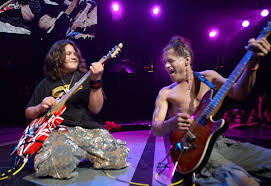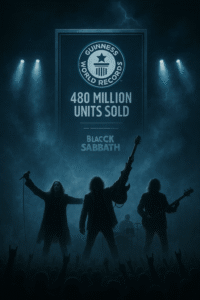
Eddie Van Halen’s name is inseparable from momentous guitar performances, energizing exhibitions, and an unmatched drive to push the limits of awesome music. Broadly celebrated as one of the most persuasive guitarists ever, Eddie Van Halen changed the sound of rock in manners that are as yet felt today. His inheritance isn’t just about his specialized authority of the guitar; it’s about his persevering development, his awesome stage presence, and his rugged obligation to the craft of music. We should investigate the existence of this remarkable performer who motivated ages of craftsmen and perpetually changed the scene of exciting music.
Early Life: A Melodic Start
Conceived Edward Lodewijk Van Halen on January 26, 1955, in Amsterdam, Netherlands, Eddie was bound for melodic significance since early on. His dad, Jan Van Halen, was a gifted jazz saxophonist and clarinetist, which implied that music was a consistent presence in the family. In 1962, the Van Halen family moved to Pasadena, California, in quest for better open doors and a new beginning. The family’s excursion to America was difficult, and monetary difficulties formed Eddie’s personality from the get-go, driving his hard working attitude and perseverance.
Eddie and his more seasoned sibling, Alex, were acquainted with old style music right off the bat throughout everyday life. Both started by learning piano under the direction of their mom. Eddie, specifically, showed monstrous ability on the piano, winning a few nearby rivalries. In any case, the customary universe of old style music would before long assume a lower priority as the young men fostered a distinct fascination with exciting music. Eddie began with the drums, and Alex with the guitar, however they immediately exchanged instruments, which would make a plan of their melodic excursion together.
See also: Alex Van Halen: The Thunder Behind Van Halen’s Amazing Sound – Biography
The Development of Van Halen: Another Power in Rock
In the mid 1970s, Eddie and Alex started performing together in Southern California, shaping a band called Beginning, which would later be renamed Mammoth. Close by their companion and bassist, Michael Anthony, and magnetic frontman, David Lee Roth, the band at last chose the name Van Halen, as it caught their novel personality. The band immediately became famous in the Los Angeles music scene, acquiring a dedicated following with fiery live shows that exhibited Eddie’s guitar ability and Roth’s colorful stage presence.
In 1977, the band grabbed the eye of unbelievable maker Ted Templeman, who assisted them with getting a record manage Warner Brothers. Records. The band’s self-named debut collection, Van Halen, was delivered in 1978 and surprised the stone world. Tracks like “Runnin’ with Satan,” “Ain’t Talkin’ ‘Session Love,” and Eddie’s famous instrumental performance “Emission” exhibited a new and valiant way to deal with exciting music. Eddie’s “Ejection” solo, specifically, acquainted audience members with his imaginative two-gave tapping method, a progressive style that would turn into a mark of his playing and impact innumerable guitarists.
Eddie’s Developments and Guitar Methods
What put Eddie Van Halen aside was his unconventional way to deal with the guitar. While numerous guitarists of the time zeroed in on soul-filled licks and conventional stone riffs, Eddie was bold in his trial and error. His two-gave tapping method, however not completely his own creation, turned into his mark, as he refined it to a degree of intricacy and speed that left crowds in wonder. He utilized it to make quick fire arpeggios and melodic successions that sounded practically like a synthesizer a genuinely clever idea in rock guitar.
Eddie’s Frankenstrat guitar was likewise a demonstration of his creativity. Disappointed with the guitars available, Eddie assumed control over issues and fabricated a custom guitar that joined components of Gibson and Bumper guitars, bringing about a novel sound that gave him the apparent flexibility he wanted. His notorious red, dark, and white-striped guitar, lovingly known as “Frankenstrat,” turned into a persevering through image of his methodology: intense, creative, and dissimilar to anything anybody had seen previously.
Past tapping and Frankenstrat, Eddie was likewise an expert of music, plunge bombs, and tremolo picking, all of which he executed with unparalleled accuracy and inventiveness. He wasn’t just playing notes; he was painting with sound, making surfaces and environments that were completely novel.
Ascend to Fame: Accomplishment with Van Halen
With Eddie in charge, Van Halen delivered a progression of fruitful collections all through the last part of the 1970s and 1980s. Collections like Van Halen II (1979), Ladies and Kids Initial (1980), and Heads up ahead of time (1981) solidified the band’s standing as quite possibly of the greatest demonstration in rock. The band’s 1984 collection, highlighting hits like “Hop,” “Panama,” and “Hot for Instructor,” denoted the pinnacle of their business achievement. “Bounce,” with its irresistible synthesizer riff, was a takeoff from the band’s guitar-weighty sound yet displayed Eddie’s flexibility as a performer.
Be that as it may, the band was not without its struggles under the surface. Pressures among Eddie and David Lee Roth, specifically, were legitimate, and in 1985, Roth passed on the band to seek after a performance vocation. Eddie and the band enrolled vocalist Sammy Hagar, which prompted another period for Van Halen. With Hagar ready, the band took a somewhat unique heading, zeroing in additional on numbers and a cleaned sound, which can be heard on collections like 5150 (1986), OU812 (1988), and For Unlawful Sexual relations (1991). However a few fans missed Roth’s wild charm, Hagar carried another aspect to the band, permitting Eddie’s playing to sparkle another way.
Individual Battles: Enslavement and Medical problems
In the background, Eddie Van Halen was engaging individual devils that would influence the two his own and proficient life. In the same way as other demigods of his period, Eddie battled with dependence. Liquor and medication use turned into a consistent piece of his life, especially during the level of Van Halen’s notoriety. His fights with dependence stressed his connections and negatively affected his wellbeing, at last prompting recovery stretches in the mid 2000s.
Eddie’s wellbeing challenges didn’t end with dependence. In the last part of the 1990s, he was determined to have tongue disease, which he ascribed to long stretches of holding metal guitar picks in his mouth while performing. He went through a medical procedure to eliminate a part of his tongue, and he was pronounced disease free in 2002. Notwithstanding this, his wellbeing kept on declining throughout the long term, and he confronted different other medical problems, including hip supplanting a medical procedure and a fight with throat disease. Eddie’s wellbeing battles were kept hidden, yet those near him knew the cost it took on his soul and strength.

A Heritage Past Van Halen
Eddie’s effect on the music world goes a long ways past the progress of Van Halen. He is generally viewed as perhaps of the best guitarist ever, close by legends like Jimi Hendrix and Eric Clapton. His impact can be heard in crafted by endless craftsmen, from hard rock and metal to pop and try and jazz. Eddie’s developments in guitar procedure opened entryways for another age of artists, a large number of whom grew up revering him and imitating his style.
Eddie’s commitments additionally reached out past his playing. He was an unbelievable writer and maker, with a profound comprehension of how to create tunes that reverberated with crowds. His work in the studio was pretty much as creative as his exhibitions in front of an audience, and he was known for his careful scrupulousness when it came to sound designing and creation.
See also: Alex Van Halen: The Thunder Behind Van Halen’s Amazing Sound – Biography
The Last Years and Getting through Impact
In 2007, Van Halen was drafted into the Rowdy Lobby of Popularity, an acknowledgment of the band’s enduring effect on exciting music. Eddie rejoined with David Lee Roth and kept on performing, pleasing fans with their exemplary hits and new material. Notwithstanding his wellbeing challenges, Eddie stayed enthusiastic about music, frequently performing and recording with his child, Wolfgang Van Halen, who joined Van Halen as the band’s bassist.
Eddie Van Halen died on October 6, 2020, at 65 years old, after a long fight with disease. The news sent shockwaves through the music world, with fans, individual performers, and pundits grieving the passing of a genuine symbol. Recognitions poured in from craftsmen across sorts, all confirming Eddie’s novel ability and his job in molding the course of music history.
The Tradition of Eddie Van Halen
Eddie Van Halen’s inheritance isn’t just about his specialized splendor; it’s about his persistent quest for advancement and his readiness to disrupt the norms. His effect on awesome music is vast, as he enlivened ages of guitarists to push past traditional limits. Eddie’s impact lives on in each guitarist who considers testing, each performer who endeavors to enhance, and each fan who feels the energy of hearing a Van Halen solo.
In a time where exciting music was developing quickly, Eddie Van Halen reclassified what it intended to be a guitarist. He wasn’t simply a performer; he was a designer, a visionary, and a trailblazer who tested the restrictions of what the guitar and exciting music could be. Today, Eddie Van Halen is recollected as a guitar god as well as a genuine craftsman who made a permanent imprint on the universe of music. His heritage perseveres, advising us that incredible music is something beyond notes and rhythms it’s about energy, advancement, and the mental fortitude to follow’s one of a kind voice.

